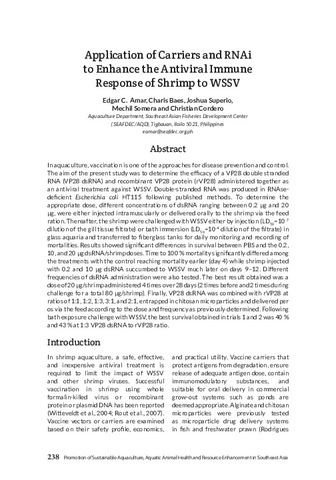Application of carriers and RNAi to enhance the antiviral immune response of shrimp to WSSV
- Global styles
- MLA
- Vancouver
- Elsevier - Harvard
- APA
- Help
Share
Abstract
In aquaculture, vaccination is one of the approaches for disease prevention and control. The aim of the present study was to determine the efficacy of a VP28 double stranded RNA (VP28 dsRNA) and recombinant VP28 protein (rVP28) administered together as an antiviral treatment against WSSV. Double-stranded RNA was produced in RNAsedeficient Escherichia coli HT115 following published methods. To determine the appropriate dose, different concentrations of dsRNA ranging between 0.2 μg and 20 μg, were either injected intramuscularly or delivered orally to the shrimp via the feed ration. Thereafter, the shrimp were challenged with WSSV either by injection (LD50=10-7 dilution of the gill tissue filtrate) or bath immersion (LD50=10-4 dilution of the filtrate) in glass aquaria and transferred to fiberglass tanks for daily monitoring and recording of mortalities. Results showed significant differences in survival between PBS and the 0.2, 10, and 20 μg dsRNA/shrimp doses. Time to 100 % mortality significantly differed among the treatments with the control reaching mortality earlier (day 4) while shrimp injected with 0.2 and 10 μg dsRNA succumbed to WSSV much later on days 9–12. Different frequencies of dsRNA administration were also tested. The best result obtained was a dose of 20 μg/shrimp administered 4 times over 28 days (2 times before and 2 times during challenge for a total 80 μg/shrimp). Finally, VP28 dsRNA was combined with rVP28 at ratios of 1:1, 1:2, 1:3, 3:1, and 2:1, entrapped in chitosan microparticles and delivered per os via the feed according to the dose and frequency as previously determined. Following bath exposure challenge with WSSV, the best survival obtained in trials 1 and 2 was 40 % and 43 % at 1:3 VP28 dsRNA to rVP28 ratio.
Suggested Citation
Amar, E. C., Baes, C., Superio, J., Somera, M., & Cordero, C. (2021). Application of carriers and RNAi to enhance the antiviral immune response of shrimp to WSSV. In F. A. Aya, L. D. de la Peña, N. D. Salayo, & E. A. Tendencia (Eds.), Proceedings of the International Workshop on the Promotion of Sustainable Aquaculture, Aquatic Animal Health, and Resource Enhancement in Southeast Asia (pp. 238–249). Tigbauan, Iloilo, Philippines: Aquaculture Department, Southeast Asian Fisheries Development Center.
Type
Conference paperISBN
9789719931102 (Print); 9789719931119 (PDF)
Except where otherwise noted, this item's license is described as Attribution-NonCommercial-ShareAlike 3.0 IGO
Related items
Showing items related by title, author, creator and subject.
-
Induction of immunity and resistance to white spot syndrome virus (WSSV) in shrimp Penaeus monodon (Fabricius) by synthetic oligodeoxynucleotide and bacterial DNA
Shrimps like all invertebrates are believed to lack true adaptive immunity but recent evidence indicate that they can be protected against pathogenic organisms by priming their immune system with immunostimulatory substances. ... -
Evaluation of dietary freeze-dried Chaetoceros calcitrans supplementation to control Vibrio harveyi infection on Penaeus monodon juvenile
Seraspe, Ebonia B.; Gabotero, Shirleny; de la Peña, Milagros R.; Pahila, Ida G.; Amar, Edgar (Elsevier, 2014)
Effects of supplementation of diets with freeze-dried Chaetoceros calcitrans to control Vibrio harveyi infection are evaluated through immune responses, and disease resistance of juvenile Penaeus monodon. Total lipid and ...
(Elsevier, 2014)
Effects of supplementation of diets with freeze-dried Chaetoceros calcitrans to control Vibrio harveyi infection are evaluated through immune responses, and disease resistance of juvenile Penaeus monodon. Total lipid and ... -
Immunity and biological methods of disease prevention and control
Almendras, Jesus Manolo E. (Aquaculture Department, Southeast Asian Fisheries Development Center, 2001)The chapter deals with the barriers that prevent microbial entry and the various internal defense mechanisms that are part of the host's arsenal in combating in combating invading microbes. It also discusses some of the ...







